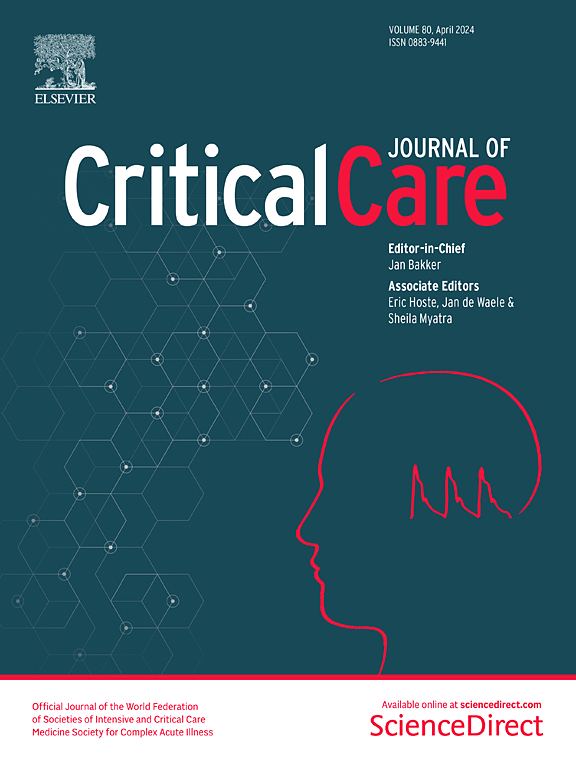硫胺素和抗坏血酸在脓毒症患者群中的差异作用通过潜在变量分析确定
IF 8.8
1区 医学
Q1 CRITICAL CARE MEDICINE
引用次数: 0
摘要
硫胺素和抗坏血酸已被提出减轻败血症和感染性休克的破坏性后果。迄今为止,随机对照试验未能证明这些疗法的益处,并且怀疑治疗效果存在异质性。在本研究中,我们旨在评估硫胺素(B1)和B1 +抗坏血酸(AA + B1)联合治疗危重症脓毒症患者疗效的异质性。我们进行了一项双中心回顾性队列研究。纳入2012年1月至2022年8月期间因脓毒症或感染性休克入住ICU的所有成年患者。根据入院24小时内获得的人口统计学和生理变量,使用潜在变量分析确定患者群。在每个聚类中,使用逆概率加权Cox模型,我们比较了接受标准治疗(对照组)、标准治疗加B1 (B1组)和标准治疗加硫胺素和抗坏血酸联合治疗(AA + B1组)患者的住院死亡率。共纳入3465例脓毒症患者,标准组2183例,B1组1054例,AA + B1组228例。以无监督的方式确定了五组患者。“重度”组包括病情最严重的患者,“中度”组主要表现为呼吸衰竭,“老年”组包括有多种合并症的老年患者,“适合”组包括年轻、健康、严重程度指数低的患者,“肝脏”组包括以肝衰竭为主的患者。B1治疗与五个组的不同结果相关。在“严重群集”和“严重群集”中,它与较低的住院死亡率相关。另一方面,硫胺素和抗坏血酸的组合与任何集群的死亡率降低无关,但与“老集群”的死亡率增加有关。这些结果强化了最近试验中报道的AA + B1联合治疗缺乏疗效,甚至引起了对老年合并症患者潜在危害的担忧。相反,我们报告了在最严重的患者和以呼吸衰竭为主的患者中,补充B1可改善ICU生存,这支持了在这一特定人群中进行进一步试验的必要性。本文章由计算机程序翻译,如有差异,请以英文原文为准。
Differential effects of thiamine and ascorbic acid in clusters of septic patients identified by latent variable analysis
Thiamine and ascorbic acid have been proposed to mitigate the devastating consequences of sepsis and septic shock. To date, randomized controlled trials have failed to demonstrate a benefit of these therapies and heterogeneity of treatment effect is suspected. In this study, we aimed at assessing the heterogeneity of treatment effect of thiamine (B1) and the combination of B1 plus ascorbic acid (AA + B1) in critically ill patients with sepsis. We conducted a bi-centric retrospective cohort study. All adult patients admitted to the ICU with sepsis or septic shock between January 2012 and August 2022 were included. Patient clusters were identified using latent variable analysis based on demographics and physiological variables obtained within 24 h of admission. Within each cluster and using inverse probability weighted Cox models, we compared in-hospital mortality between patients who received standard treatment (control), standard treatment plus B1 (B1 group), and standard treatment plus a combination of thiamine and ascorbic acid (AA + B1 group). A total of 3465 septic patients were included, 2183, 1054 and 228 in the standard, B1 and AA + B1 groups respectively. Five clusters of patients were identified in an unsupervised manner. The “Cluster Severe” included the most severely ill patients, the “Cluster Resp” patients presented with predominantly respiratory failure, the “Cluster Old” included elderly patients with multiple comorbidities, the “Cluster Fit” patients were young, healthy with low severity indices and “Cluster Liver” included patients with predominant liver failure. B1 treatment was associated with different outcomes across the five clusters. It was associated with a lower in-hospital mortality in the “Cluster Severe” and “Cluster Resp”. On the other hand, the combination of thiamine and ascorbic acid was not associated with reduced mortality in any cluster but an increased mortality in”Cluster Old”. These results reinforce the lack of efficacy of the combination of AA + B1 reported in recent trials and even raise concerns about potential harm in older patients with comorbidities. On the contrary, we reported improved ICU survival associated with B1 supplementation in the most severe patients and those with predominant respiratory failure, supporting the need for further trials in this specific population.
求助全文
通过发布文献求助,成功后即可免费获取论文全文。
去求助
来源期刊

Critical Care
医学-危重病医学
CiteScore
20.60
自引率
3.30%
发文量
348
审稿时长
1.5 months
期刊介绍:
Critical Care is an esteemed international medical journal that undergoes a rigorous peer-review process to maintain its high quality standards. Its primary objective is to enhance the healthcare services offered to critically ill patients. To achieve this, the journal focuses on gathering, exchanging, disseminating, and endorsing evidence-based information that is highly relevant to intensivists. By doing so, Critical Care seeks to provide a thorough and inclusive examination of the intensive care field.
 求助内容:
求助内容: 应助结果提醒方式:
应助结果提醒方式:


